Most of this post is copied from another recent post – but it will be extended appropriately as we add each of the upcoming sessions… Continue to work/play with “dynamic range” I.E. your limit isn’t your ability to stay upright – it’s your range of inclination (falling over!). Try to eliminate the stemming (pushing outward) of the tail of the left ski and just move the body instead – the ski responds principally to the motion of the centre of mass. So far we have only looked at “dynamics” along with skating – but it is the most important of three major fundamentals we will be developing.
Feet – for skiing in a snowplough
- Supination of subtalar joint – both feet on outside edges and turned inward
- For turning pronate the right foot’s subtalar joint to get the right ski to deflect you to the left
- Gradually add a push from this same foot/leg to move the body against the “invisible magic wall” ( on the skier’s left in this example)
Feet – for skiing parallel or skating
- Pronation of the subtalar joints of both feet simultaneously to place the feet on their inside edges
- Activation of the adductor muscles of the inner/upper legs
- Subtalar joint, adductor muscles, core all connected with tension when required
- This is for a solid support base for active dynamics/skating – so the ski is not pushed sideways (outward) and the centre of mass is moved inward (into the turn) instead
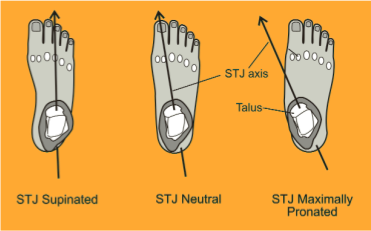

Skating
Skiing is a form of skating – it’s just that skis bend and scribe arcs on the ground and are generally used on slopes not flat lakes. Skating actions are fundamental for a skier’s development because they involve independent leg action where only one leg at a time is really used. Although skiers can stand on two feet the body is oriented specifically on one hip joint at a time (when turning) and has to function as if standing on one leg. Skating exercises such as skating step turns are helpful in developing basic skills. Skating turns use diverging skis (opposite from snowplough) and incremental stepping of the centre of mass inward toward the turn centre. This is ideally the first sort of turning that any complete beginner should experience – on flat terrain.
Basic Dynamics
- Skis must be travelling forward – like a bicycle
- This is mainly about using the outside leg (start of new turn) to push the centre of mass into the centre of the new turn – for the whole duration of the turn
- There is no “balance” when skiing – dynamics is the physics of disequilibrium
- You are looking for stability from organised accelerations (ski technology!)
- Notice in the photos below the outside leg is essentially straight in a skating action (flexion for absorption and other purposes is at the hip joint – Skating related photos added below)
- The centre of mass goes down toward the snow – and to complete the turn it comes back up – like a motorbike in a turn
- There is no “Centrifugal Force” acting on the skier – only a deflection inward away from a straight line. This deflection is used to lift the skier up at the end of the turn – which involves “finishing” the turn – I.E. turning almost back up the hill.
- Remain square to the skis (follow the skis around the turn with your body) until you are really comfortable with movement of the centre of mass and clearly aware of moving it.
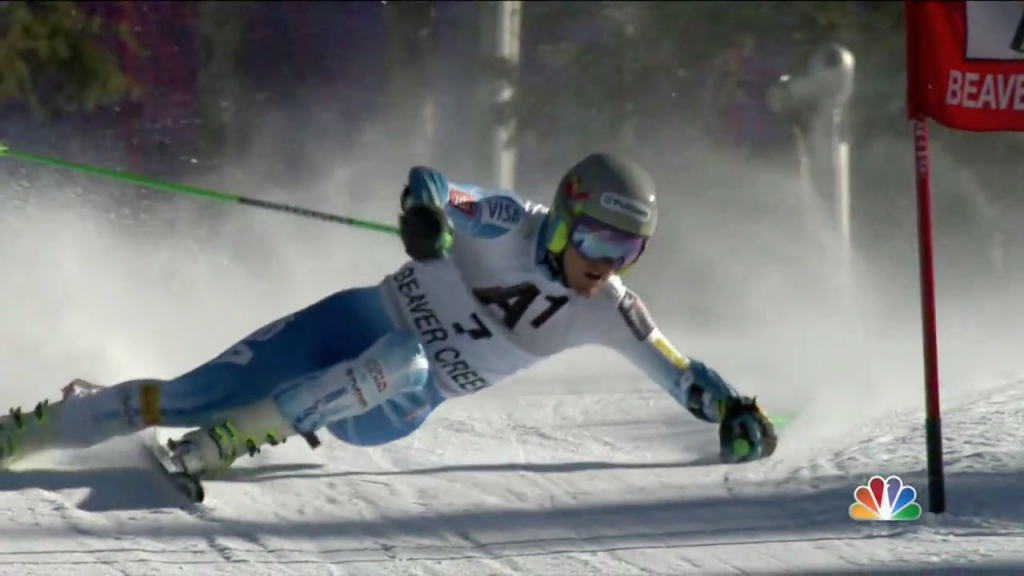

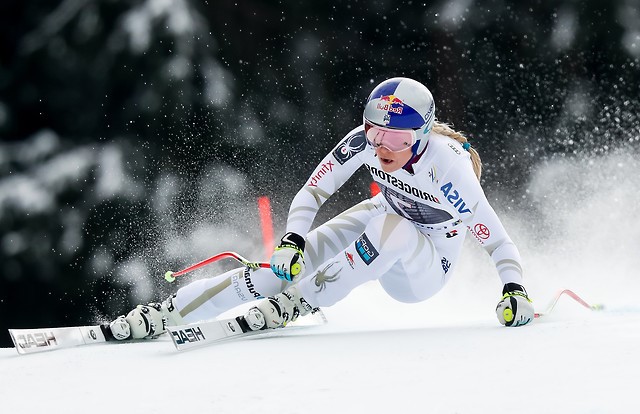
Day 2 (lesson)
Good strong extension of the outside (uphill) leg – projecting the centre of mass into the new turn and downhill (at around 45° to direction of travel). The solid stance on the outside leg – with pressure on the ski fronts – giving independence of the legs and the sensation of a skating action. Later on we added a retraction of the inside leg and bending that unweighted ankle inside the ski boot. The tendency to rotate almost completely disappeared naturally. We later started work on hip angulation (protecting the spine) to counter the rotation even more and to prepare for shorter linked turns in the future.
Side Slipping (Joystick Control of Centre of Mass)
- Feet close together (Both skis on uphill edges – both feet on inside edges)
- Move centre of mass downhill slightly to side slip
- Also move centre of mass either forward or backward to diagonally side slip
Pivot (Skis sliding Sideways)
Pivoting is derived from the skis sliding sideways and can be developed from side slipping. With a “pure pivot” as an exercise there is no forward travelling of the ski across the hill. Support for the centre of mass is now provided by support from a downhill pole plant. This is the real reason why we have ski poles! There is a full dedicated explanation of pivoting at the following link: “PIVOT“
Combining Dynamics and Pivot
- Dynamics depends of forward motion of the skis and lateral falling/pushing of the centre of mass
- Pivot depends on lateral motion of the skis – but always with the centre of mass being driven inward (toward the turn centre)
- The two can be combined – when there is both forward and lateral motion – making overall control of trajectory and speed totally under control of the skier
- In all cases there must be subtaler joint pronation of both feet constantly
- The essential element to take from combining pivot and dynamics is to execute the turn transition from the uphill edge of the uphill ski – noting that the ski enters the new turn more easily than when on its inside edge and this also prevents stemming (and body rotation)
Body Management
(Hip Angulation)
There’s a compilation of notes on the subject here: http://madeinmountains.com/chiskiing/
Take a look at the two Olympic champion skiers in the photograph below.
Killy’s image from the 1960s has his chest facing downhill whereas Noel’s image from 2022 has his chest facing forward. What Killy is doing destroys your lower back and is probably why he never went on skis again after he stopped racing.

Protecting the Spine
- Hold the front of the pelvis up – aiming for “neutral pelvis”
- During the turn pull the outer hip backwards so that the ski doesn’t pull it in front of your ribs
- Look for a stretch between the ribs and hip joint
- Look for a reflex contraction of the lower abdominals – the postural reflex
- Keep the shoulders/chest following the skis (to some degree)
- Always “counter turn” the pelvis more than the chest/shoulders
- For tighter turns with more pivoting start to use the pole plant to some degree
- The more “countered” the pelvis the more the next turn can be “anticipated”
Source of Hip Angulation
The upper body needs to tilt forward over one hip joint – then rotate around it. This is in addition to pulling back the outside hip etc.
The body shape produced alters the location of the centre of mass enabling pressure on the ski fronts and also greater agility both into and out of turns – and pole planting if the skis are swinging laterally.
The hip angulation also provides flexion of the hip joint that gives absorption of shocks.
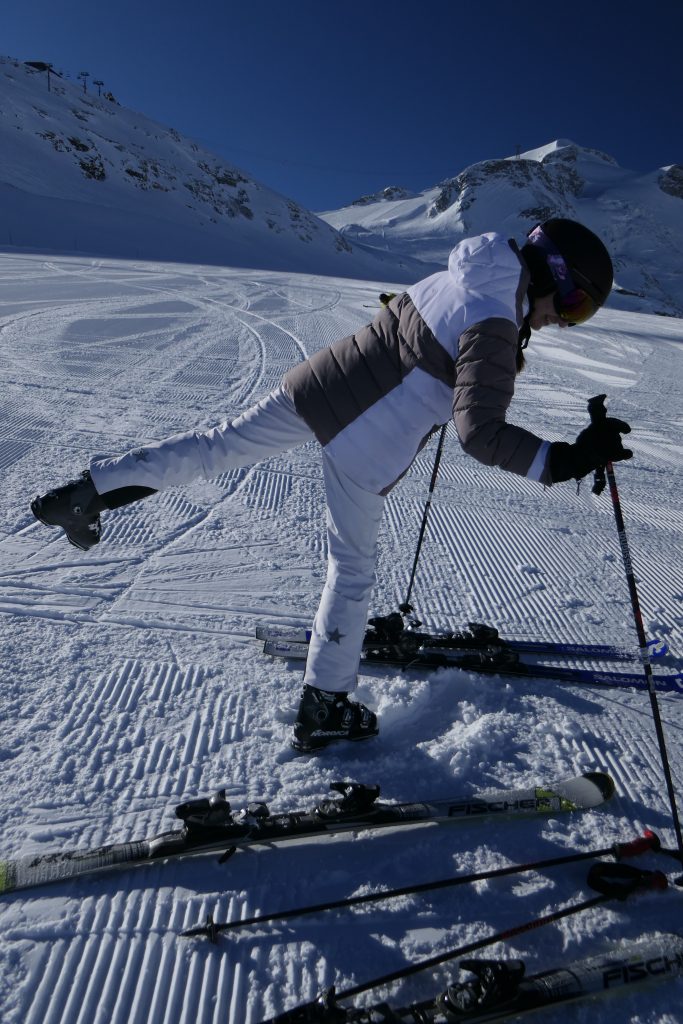
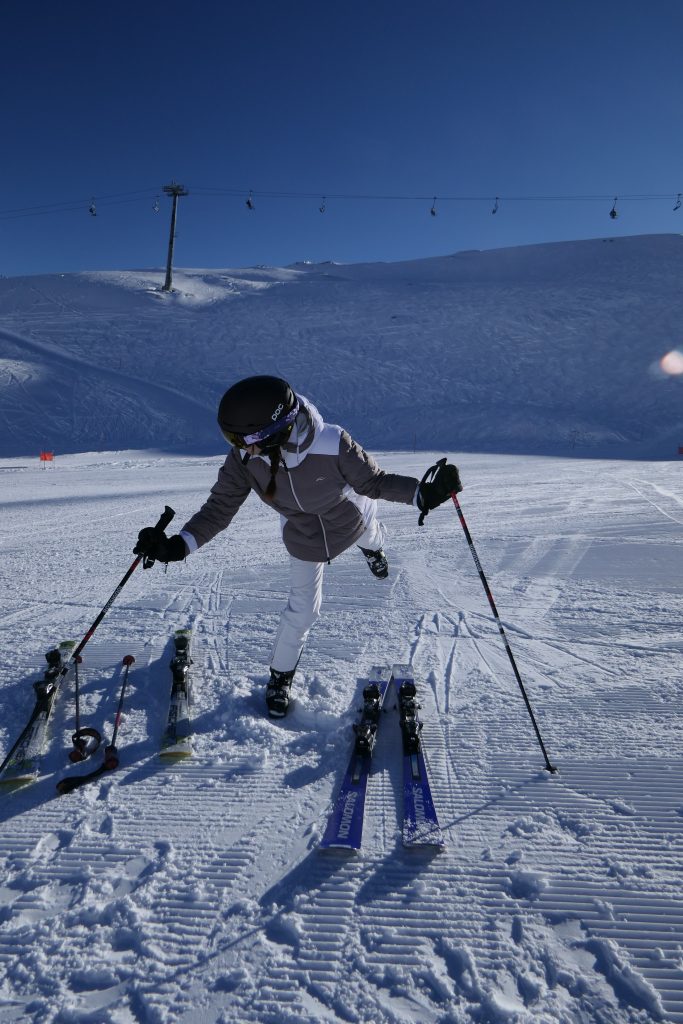
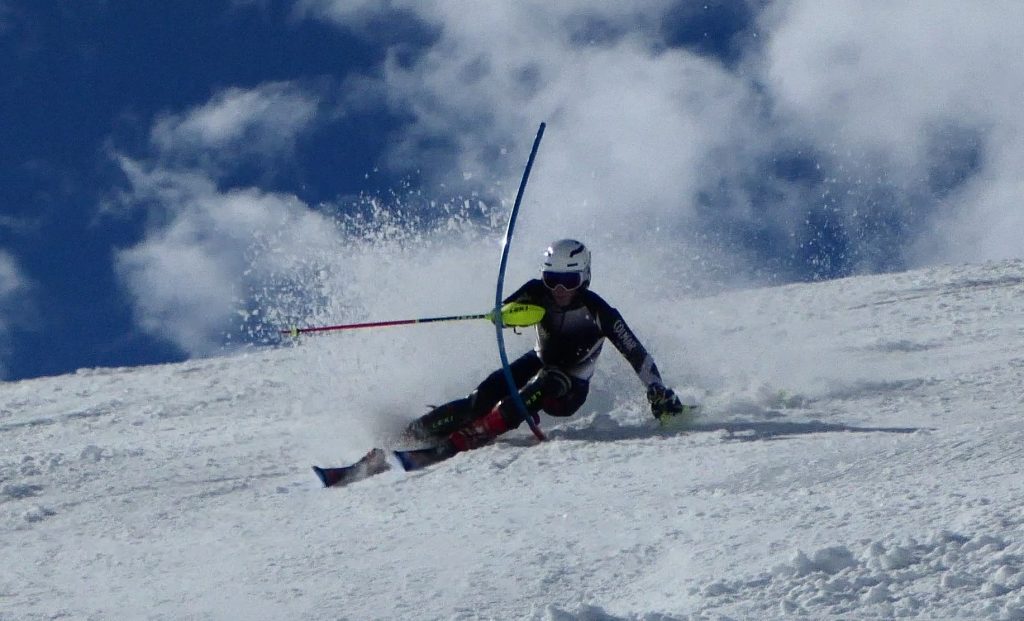
Pressure on the ski fronts
Day 3
Linking Turns – Dynamics and Rhythm
Linking short turns requires the skills of “pivoting” – swinging the skis laterally and supporting the centre of mass with a solid downhill planted ski pole. To make this happen fluidly you have to turn almost back up the hill – generating hip angulation and keeping the pelvis facing more or less downhill then actively let the upper body cross over the downhill ski to get the ski pole planted – taking you directly into the next turn. When you can do this – you can ski at a controlled speed down just about anything.
After a warm up run focused on dynamics we worked on side slipping and then pivoting. Lucy taught me how to do a pivot backwards – which I didn’t even know I could do. Returning to pivoting forwards there was a bit of work on body management – hip angulation to bring the centre of mass forward. We also worked on arm carriage with the ski poles laid across the back of the outstretched arms/hands so the hands were in the “ready” position. We also practiced hockey stops but with driving the centre of mass uphill (usually done by pushing the ski tails downhill!) Short Swings (linked jump turns) were also practiced.
Lucy managed to use the dynamics at the end of the short turns – letting her body be brought out of each turn over the lower ski and linking into the next turn. The improvement to look for next is to do this enough to manage to get the support of the pole being planted downhill – but this also depends on the tightness of the turns and the more the skis are travelling laterally the more the pole is required.
Arm Carriage and Upper Body
- The basic carriage for arms is wide apart and in front – for stability and agility
- Lower the shoulders to release tension
- Tilt the upper body forward at the hip joints (don’t straighten up between turns)
- Keep the hips above the feet (I.E. don’t sit down backwards)

The following is a “reasonably” good video of the process – with some extra jump turns added for good measure because it’s off piste.

